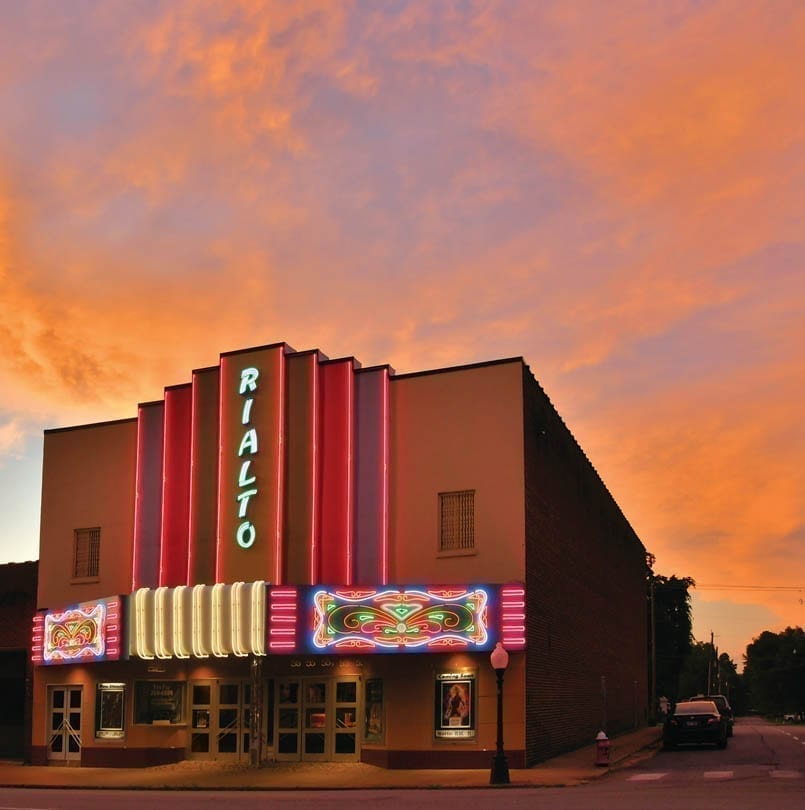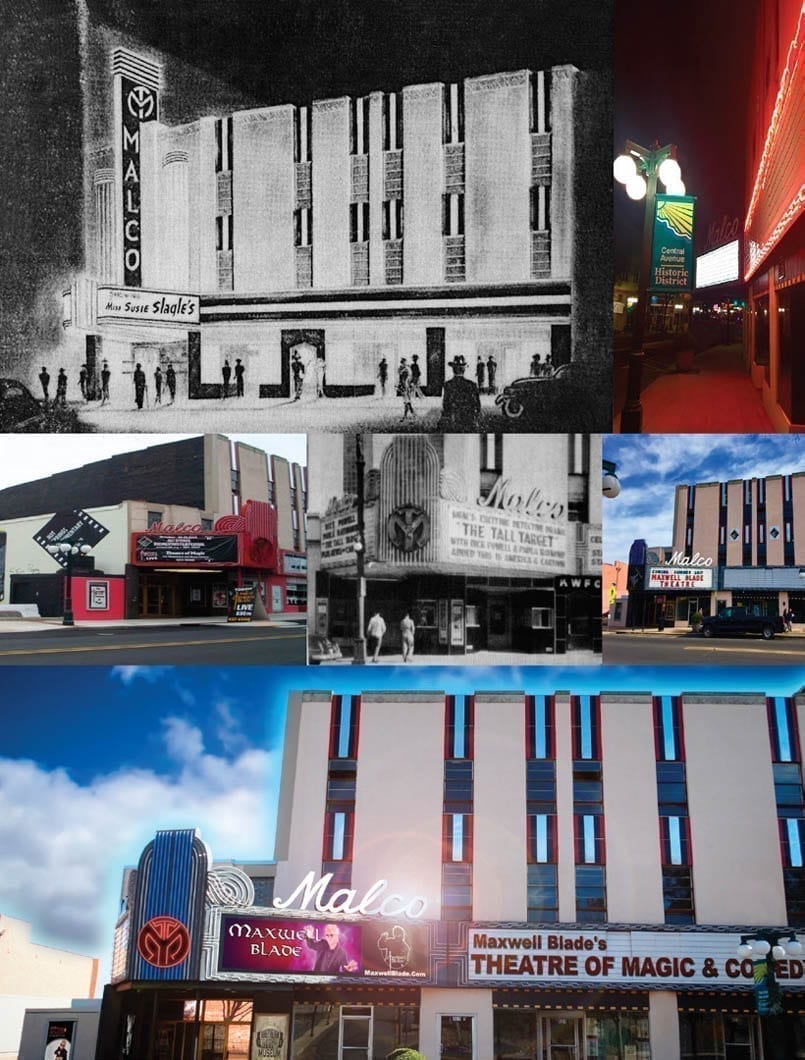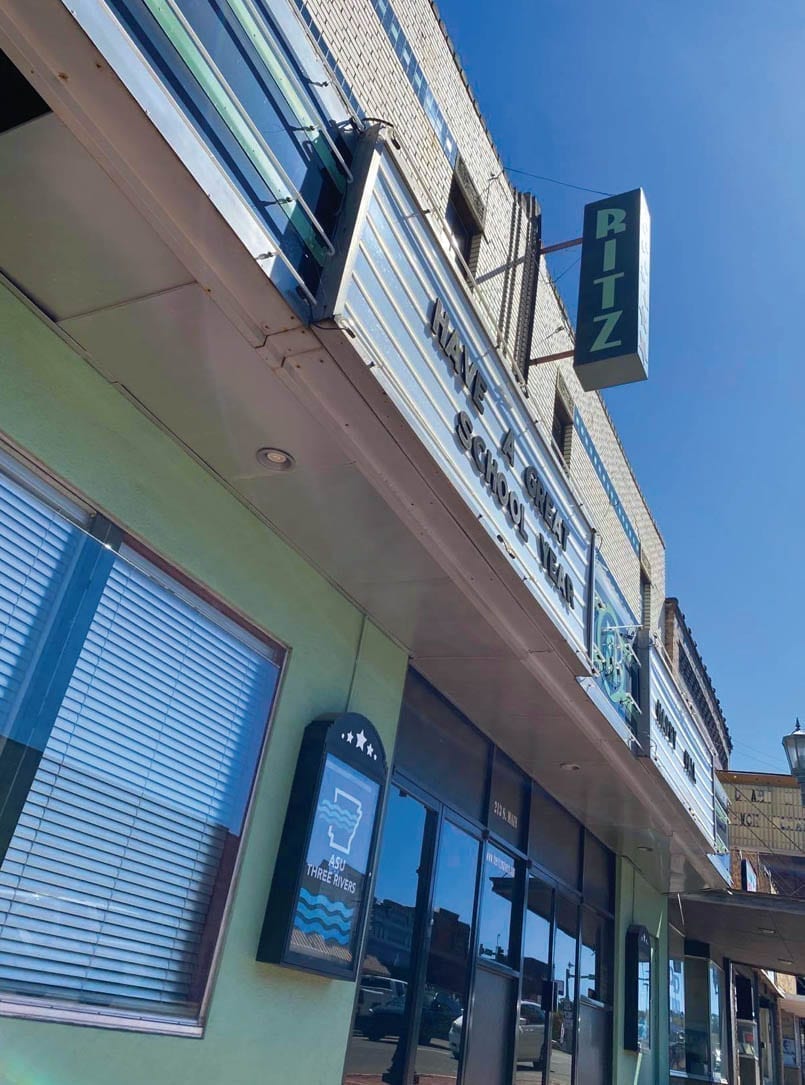29 Oct 2020 The Show Must Go On: Historic theaters find new life in the 501
by Dwain Hebda
The center of small-town entertainment and a slice of Arkansas nostalgia, the Main Street movie theater is making a comeback throughout Central Arkansas. Across the 501, you can see them, saved from the rubble heap, lit up in neon finery and beckoning from across
the generations.
Here’s a profile of four of these beauties at various stages of resurrection.
The Rialto Theatre
100 West Race Ave. • Searcy
It doesn’t take much to imagine what a stunner the Rialto Theatre was in her prime. The glass tile front, art deco design and sparkling neon are still enchanting, even as the antique movie house waits for the funding to finish her makeover.
To Searcy natives like Amy Burton, executive director of Main Street Searcy, the Rialto is essential to the soul of downtown.

“It’s the heritage of it that makes it important to downtown,” she said. “In my mind, there is a distinction between history and heritage. And of course, there is historical significance to the building. It is on the National Register of Historic Places. It is architecturally significant with that art deco design.
“But apart from that, it really is a piece of heritage because you look at how many generations where that was the only movie theater for many, many years. And you look at the firsts — first dates, first kisses, first R-rated movie, you know? There are so many sentimental feelings about that theater.”
Once known as the Grand Theatre, the Rialto was built in 1924 as a rather pedestrian-looking building. In the late 1940’s, however, ownership did a remodel that applied the art deco touches that give the movie house its distinct look.
“A lot of people assume that art deco design is original to the theater, but underneath the neon and the glass it is just a brown brick building,” Burton said. “In 1949, the neon marquee went up, and then the glass on the front and it got new sound, a new movie screen. All of that went in the late ’40s.”
The Rialto was the site of various entertainment and events in addition to movies. Jasper, the most popular movie dog of the 1920s, paid an in-person visit to the cinema, as did country singer Tex Winter in 1939. As the Rialto was in constant competition with the Plaza Theatre, a number of promotional stunts also occurred, to the delight of residents.
Like a lot of small-town movie houses, the 1980s began an era too tough for the 300-seat Rialto to compete, and by the mid-1990’s, it was deeded to the city. It has been a functioning theater showing second-run, family movies over the past few years.
Meanwhile, several community stakeholders have worked together to fund renovations, including the city, the Main Street program, the Searcy Regional Economic Development Committee and others. Together, they have brought the exterior back to life and are on the brink of a capital campaign to address interior elements to delight many more generations of moviegoers.
“I’ve heard so many great stories as we’ve worked through this project,” Burton said. “If you grew up in Searcy, odds are you have a Rialto story to tell.”
Malco Theatre
817 Central Ave. • Hot Springs

There’s something magical about the Malco Theatre, and that’s not just a figure of speech. The art deco beauty in the heart of the Hot Springs historic district is home to Maxwell Blade’s Theatre of Magic and Comedy, where audiences from all over the world come to enjoy the longtime illusionist’s dazzling show.
“I sat down one day and went, ‘OK, is this what I’m going to do?’” Blade said. “Because if I’m going to do it, I’m going to do it right. The answer was yes.”
Blade had the passion and the backing to, in his words, “come home to the Malco” after years as a touring magician and stints in other venues, but bringing the Hot Springs landmark back to glory was a monumental undertaking that continues today.
“People come in the front door and they don’t expect much down here. This is a huge building,” Blade said. “It took maybe $800,000 and 14 months because we stripped it. There were holes in the ceiling and there were other issues, so we gutted it. We had electricians come in, and we had engineers draw the plan.”
Built as the Princess Theatre in 1910, the structure showed silent films and hosted vaudeville acts before converting to talkies in 1929. On Christmas Eve 1935, fire took the structure down to its foundation and masonry entrance facing Broadway. Per the Encyclopedia of Arkansas, the theater was rebuilt and quickly sold to M. A. Lightman of Memphis, a successful theater owner and founder of the Malco Theatre group. Renamed the Malco Theatre, it was renovated in 1946 to showplace status, featuring the finest projection and sound equipment of any theater in the South.
Behind the glowing neon and brightly lit marquee was the theater’s less-flattering policy of segregated entrances and seating, which existed between 1929 and 1964. Ironically, this sad remnant of pre-civil rights Arkansas is now an important historical artifact; the Arkansas Historic Preservation Program has stated that the Broadway entrance to the theater may be one of only two formerly segregated entrances still in existence in the United States.
The historic entrance is slated for restoration, and Blade, whose show was housed here in the 1990s and who came home to stay in 2017, has every intention of preserving it as a reminder of the struggle for equality. That, as well as the other fascinating areas within the theater, combine for a living time capsule of Hot Springs lore.
“[The Malco] is going to be here long after I’m gone,” he said. “It was an investment not only in myself, but in the City of Hot Springs. As all the new [downtown] developments have come to pass, I think it’s well worth it.”
The Ritz Theatre
213 South Main St. • Malvern
Movie theaters provide a wealth of memories that are essential to a person’s upbringing. First dates, family outings and favorite films all form a powerful emotional connection between the community and the theater itself.
So when the Ritz Theatre closed its doors for good in December 2018, alarms started going off all over Malvern, which had enjoyed the Main Street cinema for 80 years. And salvation came quickly from the local community college.

In March 2019, Arkansas State University Three Rivers (then College of the Ouachitas) announced it was buying the landmark Ritz Theatre with plans on restoring it to its former neon-laced glory.
“The College has lots of good things on the horizon, and the purchase of the theater is one of the greatest,” Dr. Steve Rook, university chancellor, said at the time. “It is our hope that the restorations we plan to make to the property will be the catalyst that starts a revitalization of the downtown area.”
The university announced plans to return the theater to its original footprint with a single open theater and stage at the front and an open, functioning balcony. It will retain its ability to show movies, but the planned usage goes well beyond that.
“The theater will become a community performing arts center, and the university will hold special events at the theater while also making it available to community organizations and individuals,” Rook said. “A facility such as this has been discussed in the Hot Spring County Conversations meetings, and our plan is to make it a reality.”
Like many historic theaters, the Ritz’s story is a tale of ups and downs that mirror that of small-town Arkansas itself. Built in 1938 and rebuilt after a fire in 1947, it was the second-longest active movie theater west of the Mississippi River at the time it closed. During its run, it had the distinction of being the first movie theater in the South to feature air conditioning. But changing times and changing entertainment tastes eventually doomed the Ritz Theatre as a commercial venture.
Now, the residents of Malvern are excited for what the future holds for the historic structure. And they won’t have to wait long as ASU Three Rivers has been successful in landing grants to revitalize The Ritz permanently.
“What a significant accomplishment this is for Malvern, Hot Spring County, ASU Three Rivers and the historic Ritz Theatre,” Rook said. “I’m really excited to see this project get underway and for the community to begin to see progress to its theater.”
- The pinnacle of success - June 1, 2025
- Five-Oh-Ones to Watch 2025: Aaron Farris - December 31, 2024
- Julia Gaffney brings medals and mettle home to Mayflower - October 30, 2024











